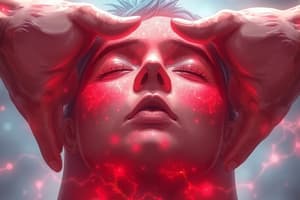Podcast
Questions and Answers
Which of the following is a common drug reaction associated with photosensitivity?
Which of the following is a common drug reaction associated with photosensitivity?
- Allopurinol
- NSAIDs (correct)
- Bactrim
- Penicillin
Which of the following is NOT a common drug associated with Stevens-Johnson Syndrome (SJS) and Toxic Epidermal Necrolysis (TEN)?
Which of the following is NOT a common drug associated with Stevens-Johnson Syndrome (SJS) and Toxic Epidermal Necrolysis (TEN)?
- Doxycycline (correct)
- Allopurinol
- Sulfa drugs
- Anticonvulsants
Which of the following is a characteristic feature of Erythema Multiforme Major?
Which of the following is a characteristic feature of Erythema Multiforme Major?
- Absence of systemic symptoms
- Significant mucosal involvement (correct)
- Minimal mucosal involvement
- Associated with HSV only
Which of the following is a characteristic feature of Bullous Pemphigoid?
Which of the following is a characteristic feature of Bullous Pemphigoid?
What is the most common subepidermal autoimmune blistering disease?
What is the most common subepidermal autoimmune blistering disease?
Which of the following is a characteristic feature of Dermatitis Herpetiformis?
Which of the following is a characteristic feature of Dermatitis Herpetiformis?
What is the primary treatment for Dermatitis Herpetiformis?
What is the primary treatment for Dermatitis Herpetiformis?
What is the most common type of skin cancer?
What is the most common type of skin cancer?
What is the most common drug reaction?
What is the most common drug reaction?
Which of the following is a precancerous lesion?
Which of the following is a precancerous lesion?
What is the typical appearance of Actinic Keratosis?
What is the typical appearance of Actinic Keratosis?
What is the most common cause of Fixed Drug Eruption?
What is the most common cause of Fixed Drug Eruption?
Which of these is NOT a treatment option for urticaria?
Which of these is NOT a treatment option for urticaria?
Which of the following is a common trigger for spontaneous urticaria?
Which of the following is a common trigger for spontaneous urticaria?
What is the most effective treatment for Erythema Multiforme?
What is the most effective treatment for Erythema Multiforme?
What is the key factor in determining the prognosis of Stevens-Johnson Syndrome and Toxic Epidermal Necrolysis?
What is the key factor in determining the prognosis of Stevens-Johnson Syndrome and Toxic Epidermal Necrolysis?
Which of the following is NOT a risk factor for Melanoma?
Which of the following is NOT a risk factor for Melanoma?
What is the most common type of Melanoma?
What is the most common type of Melanoma?
Which of the following is a characteristic of Basal Cell Carcinoma (BCC)?
Which of the following is a characteristic of Basal Cell Carcinoma (BCC)?
Which of the following is a treatment option for Squamous Cell Carcinoma?
Which of the following is a treatment option for Squamous Cell Carcinoma?
What is the main cause of Venous Stasis Ulcers?
What is the main cause of Venous Stasis Ulcers?
Which of the following is NOT a risk factor for pressure ulcers?
Which of the following is NOT a risk factor for pressure ulcers?
What is the typical presentation of Lichen Sclerosus?
What is the typical presentation of Lichen Sclerosus?
Which of the following is a common treatment for Acanthosis Nigricans?
Which of the following is a common treatment for Acanthosis Nigricans?
Which of the following is a risk factor for Vitiligo?
Which of the following is a risk factor for Vitiligo?
Which of the following is a common characteristic of Arterial Leg Ulcers?
Which of the following is a common characteristic of Arterial Leg Ulcers?
What is the best treatment for a Stage 4 pressure ulcer?
What is the best treatment for a Stage 4 pressure ulcer?
Which of the following is NOT a risk factor for Venous Stasis Ulcers?
Which of the following is NOT a risk factor for Venous Stasis Ulcers?
What is the most likely diagnosis for a patient with a hyperpigmented macular patch following an injury?
What is the most likely diagnosis for a patient with a hyperpigmented macular patch following an injury?
Which of the following is NOT a common clinical finding in venous stasis dermatitis?
Which of the following is NOT a common clinical finding in venous stasis dermatitis?
Which type of biopsy is MOST appropriate for a lesion that is ABOVE the skin surface?
Which type of biopsy is MOST appropriate for a lesion that is ABOVE the skin surface?
Flashcards
Urticaria
Urticaria
Swollen, red wheals on the skin, can be acute or chronic.
Types of Urticaria
Types of Urticaria
Includes spontaneous, cold, solar, delayed pressure and dermographism.
Acute Urticaria Duration
Acute Urticaria Duration
Lasts for up to 6 weeks; often idiopathic.
Autoimmune Urticaria Causes
Autoimmune Urticaria Causes
Signup and view all the flashcards
H. Pylori and Urticaria
H. Pylori and Urticaria
Signup and view all the flashcards
First Treatment for Urticaria
First Treatment for Urticaria
Signup and view all the flashcards
Red Man Syndrome
Red Man Syndrome
Signup and view all the flashcards
Basal Cell Carcinoma (BCC)
Basal Cell Carcinoma (BCC)
Signup and view all the flashcards
Fixed Drug Eruption
Fixed Drug Eruption
Signup and view all the flashcards
Photosensitivity
Photosensitivity
Signup and view all the flashcards
Nodular BCC
Nodular BCC
Signup and view all the flashcards
Erythema Multiforme Minor
Erythema Multiforme Minor
Signup and view all the flashcards
Squamous Cell Carcinoma (SCC)
Squamous Cell Carcinoma (SCC)
Signup and view all the flashcards
Stevens-Johnson Syndrome (SJS)
Stevens-Johnson Syndrome (SJS)
Signup and view all the flashcards
Melanoma
Melanoma
Signup and view all the flashcards
Merkel Cell Carcinoma
Merkel Cell Carcinoma
Signup and view all the flashcards
Pemphigus Vulgaris
Pemphigus Vulgaris
Signup and view all the flashcards
Bullous Pemphigoid
Bullous Pemphigoid
Signup and view all the flashcards
Kaposi Sarcoma
Kaposi Sarcoma
Signup and view all the flashcards
Actinic Keratosis
Actinic Keratosis
Signup and view all the flashcards
Melasma
Melasma
Signup and view all the flashcards
Basal Cell Carcinoma
Basal Cell Carcinoma
Signup and view all the flashcards
Post Inflammatory Hyperpigmentation
Post Inflammatory Hyperpigmentation
Signup and view all the flashcards
Acanthosis Nigricans
Acanthosis Nigricans
Signup and view all the flashcards
Vitiligo
Vitiligo
Signup and view all the flashcards
Pressure Ulcers
Pressure Ulcers
Signup and view all the flashcards
Arterial Ulcer
Arterial Ulcer
Signup and view all the flashcards
Venous Stasis Ulcers
Venous Stasis Ulcers
Signup and view all the flashcards
Stasis Dermatitis
Stasis Dermatitis
Signup and view all the flashcards
Shave Biopsy
Shave Biopsy
Signup and view all the flashcards
Study Notes
Urticaria (Hives)
- Erythematous wheals (raised, red skin)
- Types: spontaneous, cold, solar, delayed pressure, dermographism
- Acute (<6 weeks) or Chronic (>6 weeks)
- 50% idiopathic (no known cause)
- 40-50% autoimmune (linked to thyroid issues)
- Can be associated with Helicobacter pylori (H. pylori)
- Treatment:
- First-line: antihistamine daily
- Second-line: antihistamine four times a day
- Third-line: Dupixent, Doxycycline, or Cyclosporine
- Fourth-line: Allergist consultation, Zolair + cetirizine
- Address any known triggers
- Consider workup if angioedema or constitutional symptoms present
Common Drug Reactions
- Penicillin is a frequent culprit
- Bactrim is sometimes a severe reaction.
- Morbilliform rash (exanthema) often generalized on the trunk
- Typically appears 7-14 days after exposure
Red Man Syndrome
- Macular erythema (red rash)
- Starts on the back of the neck then spreads to trunk, face, and arms
- Pruritus (itching)
- Sometimes hypotension (low blood pressure)
- Treatment: antihistamines, topical steroids, slow infusion
Fixed Drug Eruption
- Round or oval patches at a fixed location
- Develops 1-2 weeks after first exposure
- More lesions can develop with repeated exposure
- NSAIDs (e.g., naproxen) are a frequent cause
- Rule out cupping
Photosensitivity Reactions
- UVA exposure can cause phototoxic reactions that mimic severe sunburns.
- Phototoxic reactions are not dependent on prior sensitization.
- NSAIDs and tetracyclines are potential causes for phototoxic reactions
- Hydrochlorothiazide, photosensitivity reactions present as photoallergic reactions where prior sensitization is a requirement
- Sulfa medications can also cause these kinds of reactions
Erythema Multiforme
- Minor: Associated with herpes simplex virus (HSV)
- No systemic symptoms, mild mucosal involvement
- Major: Associated with Mycoplasma or HSV
- Systemic symptoms, significant mucosal involvement.
Stevens-Johnson Syndrome & Toxic Epidermal Necrolysis (TEN)
- Drug eruption (rash) 7-21 days after taking medication
- Mucosal involvement & skin peeling , organ damage
- Common drugs: Allopurinol, sulfa drugs, anticonvulsants
- Severity classified based on body surface area affected (<10% = Steven Johnson, 10-30% = both, >30% = TEN)
- Prognosis depends on how quickly the offending drug is discontinued
- Treatment: Burn unit, gynecology, ophthalmology.
Pemphigus Vulgaris
- Autoimmune epidermal blistering disease in the spinosum layer.
- Blood work for desmoglein 1 and 3
- Treatment: Topical steroid, oral steroid, rituximab (for moderate to severe cases).
Bullous Pemphigoid (BP)
- Autoimmune subepidermal blistering disease at the dermal-epidermal junction (DEJ)
- Most common subepidermal autoimmune blistering disease
- Blisters are tense and do not break easily
- Neurological disorders (e.g., multiple sclerosis, stroke, bipolar disorder, and dementia) may be associated.
- Treatment: topical steroids for mild cases, oral steroids and rituximab for moderate/severe cases.
Dermatitis Herpetiformis
- Cutaneous manifestation of celiac disease
- Strong association with thyroid issues
- Grouped vesicular papules (itchy)
- Treatment: gluten-free diet, dapsone
Actinic Keratosis
- Small, dry, rough, erythematous, and flaky lesions
- Precancerous skin lesions caused by sun exposure.
- 10% can develop into squamous cell carcinoma (SCC)
- Treatment: Cryotherapy for a few lesions, 5-fluorouracil (5-FU) for multiple lesions (applied twice a day for 2-4 weeks)
Basal Cell Carcinoma (BCC)
- Most common skin cancer
- Rarely metastasizes
- Increased risk with sun exposure and genetic factors
- Superficial BCC: Affects the epidermis
- Treatment: Electrodesiccation and curettage (ED&C), 5-fluorouracil (5-FU), surgical excision, Mohs surgery
Squamous Cell Carcinoma (SCC):
- Second most common skin cancer
- High risk of metastasis
- Risk factors include: sun exposure, HPV, smoking, immunocompromised state.
- Treatment: In situ (epidermis): ED&C, topical 5-FU. In invasive (dermis): Excision, Mohs surgery
Melanoma
- Most common type is superficial
- Follow up with dermatologist every 3 months for the first 2 years of diagnosis.
- Dysplastic nevi: Mild to moderate — reassurance, Severe — MIS
- Important factor is depth in determining treatment
- Treatment varies based on depth (excision of melanoma in situ (MIS)) with 1 cm margins) or referral to general surgery in cases with deeper melanoma involvement.
Merkel Cell Carcinoma
- Rare, aggressive, and often large.
- Characteristic of coming from nowhere on the skin surface.
- Biopsy: Punch or shave.
- Referral to Oncology
Kaposi Sarcoma
- Rare skin cancer
- Associated with human herpesvirus 8 (HHV8).
- History of immunocompromised (or organ transplant) is often reported.
Melasma
- Symmetric, hyperpigmented macular patches.
- On sun-exposed areas (face, cheeks, forehead, neck).
- Often light brown or dark brown.
- Risk factors: Female, pregnancy, oral contraceptives
- Treatment: Hydroquinone, oral and topical steroids. Always wear sunscreen.
Post Inflammatory Hyperpigmentation (PIH)
- Hyperpigmented patches after skin injury or trauma.
- Common in Fitzpatrick skin types 4–6.
- Resolves within 6–12 months but Hydroquinone can speed the process up.
- Treatment: Sunscreen, Hydroquinone .
Acanthosis Nigricans
- Hyperpigmented, velvety patches or plaques.
- On neck, axilla, groin, and mammary areas.
- Linked to: Insulin resistance, obesity, metabolic disorders
- Treatment: Topical retinoids, keratolytics.
Vitiligo
- Depigmented macules and patches on the skin.
- Destruction of melanocytes, leading to depigmentation.
- Risk factors: Family history, thyroid issues.
- Treatment: Sunscreen, topical steroids, tacrolimus, topical Vitamin D,.
Lichen Sclerosus
- Atrophie papule with a pink rim
- Risk Factors: Autoimmune dysfunction, previous history of skin disease, and family history.
- Common on the genitals in women (10:1 ratio with men).
- Treatment: High-potency topical steroids, systemic therapies (e.g., oral steroids, methotrexate, cyclosporine), laser/PRP/surgery
- Biopsy for diagnosing and ruling out potential squamous cell carcinoma (SCC).
Pressure Wounds
- Bed sores due to prolonged pressure.
- Common locations: heels, sacrum, malleolus, greater trochanter
- Risk factors: Sensory deficits, age, poor nutrition, prolonged immobility.
- Stages: 1-4 (first is intact skin, 4th involves bone and muscle)
- Treatment: Wound care, moisture management, sepsis prevention.
Arterial Ulceration
- Punched-out appearance
- Severe pain with movement.
- Dependent rubor (redness when dependent).
- Pallor on elevation.
- Shiny atrophic skin, alopecia (hair loss).
- Diagnose with ankle-brachial index.
- No compression socks.
Venous Stasis Ulcers
- Most common vascular ulcer
- Usually in the lower leg, medial malleolus
- Risk Factors: Tobacco use, Diabetes.
Stasis Dermatitis
- Dry, pruritic, scaly, hyperpigmented rash on legs (due to venous insufficiency).
- Symptoms: Asymptomatic at first, then skin changes.
- Class 4 on spectrum: Hyperpigmentation, lipodermatosclerosis, atrophie blanche.
- Treatment: Compression stockings, (steroids for itching if no infection), vascular care referral
Shave Biopsy
- For lesions above the skin surface (skin tags, intradermal nevi, etc.)
- Epidermis and upper dermis are removed.
Punch Biopsy
- Goes deeper than a shave biopsy
- Used for lesions that require more tissue or for cosmetically sensitive regions and for lesions that are suspected to be on the blood thinners.
- Epidermis and dermis are removed.
Cryotherapy
- Non-invasive (uses cryogen)
- Treatment for benign and premalignant skin lesions.
- Two freeze-thaw cycles.
Studying That Suits You
Use AI to generate personalized quizzes and flashcards to suit your learning preferences.
Related Documents
Description
Test your knowledge on urticaria, common drug reactions, and conditions like Red Man Syndrome. This quiz covers the types, causes, treatments, and symptoms associated with these dermatological issues. Perfect for students and professionals in the medical field.



